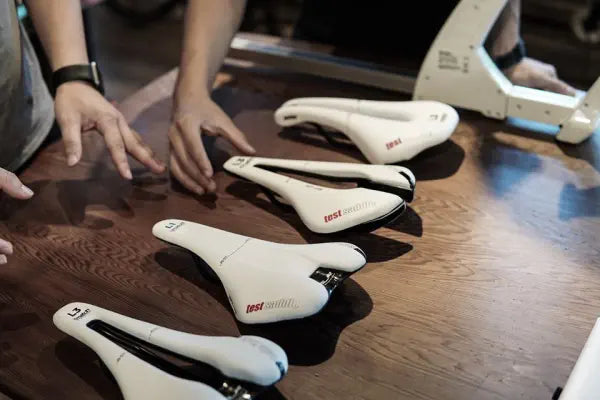
How to set your saddle height
All of your cycling trips should be comfortable and efficient. Having the correct saddle height is essential to achieve this and avoiding injuries. As well as fitting the correct saddle, it’s height is the foundation of setting up your optimum bike position.
Your saddle height measurement is the distance from the pedal to the top of your saddle with the crank arm down and in line with the seat tube. It may also be measured from the centre of the bottom bracket to the top of the saddle, but this does not take into account crank length.
The best way to set your saddle height
Hands down the best way to get the correct saddle height is to get a professional bike fit. A fitter will take into account a wide range of measurements and personal characteristics to achieve your optimal position. These services may seem expensive but if you ride regularly, it is money well spent and will last you a long time. If you buy a new bike in the future, you can just set that up the same.
DIY setup
Over the years a number of basic saddle height methods have appeared that can be used as a starting point for newbies. Most are based on a relationship between saddle height and leg length (your inseam), or a knee angle range. However, none of them take into account individual characteristics such as your flexibility, pedalling style or limb proportions. Their formulas are based on averages and maths, so it’s worth being concious that they may not give an accurate result for some riders, only a ball park figure.

The Heel method
This method requires no equipment and is a really quick and easy way to set your saddle height. It’s a useful method if you quickly need to setup a gym bike, for example.
With the crank arm in line with the seat post, sit on the saddle and put your heel on the pedal with the knee fully straight and locked out. Now pedal backwards. If you can without losing heel contact at the bottom of the pedal stroke or tilting your pelvis down then your good. Place the ball of your foot on the pedal and pedal normally.
The Holmes method
The Holmes method finds your saddle height by measuring your static knee angle at the bottom of the pedal stroke. It states it should be between 25 and 35 degrees. However obtaining this measurement is more difficult but regarded as more accurate than simple formula-based methods. Either have someone help you or you can use a bike fit app on a phone or tablet to film you side on. On a static trainer, pedal until you feel comfortable, then stop at the bottom of the pedal stroke. The angle of your knee at this point should be within the range.
Further Reading
- How to ride an Electric Bike
- Can an Ebike make you ride more?
- Top 10 Health Benefits of Riding an Ebike
The LeMond method
This method calculates saddle height by multiplying your inseam by 0.883. The measurement is from the centre of the bottom bracket to the top of the saddle. It does not take into account your crank length.
To measure your inseam, stand against a wall in bare feet, shoulder width apart. Place a book, or something similar, up between your legs. Mark the point on the wall at the top of the book and measure this distance to the floor. This is your inseam measurement. Multiply by 0.883 and set your saddle height from the centre of your bottom bracket to that.
The Hamley method
This method is similar to the Lemond method but incoporates the crank length too. Obtain your inseam measurement as above and multiply it by 1.09. Set the height of your saddle from the surface of your pedal inline with the seat tube.
What else influences saddle height?
Ankle position can help determine what height your saddle should be set to but also indicate your saddle height is not correct. For example, those who pedal toes down will have relatively less knee extension and a lower saddle or it may be compensation for a saddle that is too high with the foot ‘reaching’ for the bottom of the pedal stroke.
The actual effort you put in can affect saddle height too. Some riders change their pedalling style under high load.
Hamstring flexibility affect knee angle while pedalling. Short hamstrings often need a lower saddle position.
Your position on the saddle will influence the saddle height too. Sliding forward will effectively lower the saddle while sitting towards the back will effectively raise it slightly.
Equipment such as shoes and pedals may have different sole thicknesses and stack heights. And believe it the chamois’ on different bib shorts may have different thicknesses. So your saddle height may need to be adjusted if changing equipment.

How to check your saddle height is correct
Correct saddle height should result in:
- A stable pelvis, no tilting side to side as you pedal
- Stable feet, no excessive toe down or heel down.
- A smooth pedal stroke
- Keeping still on the saddle, no constant moving about
- A balanced recruitment of your leg muscles
- Minimal knee discomfort
Pedalling is a repetitive function and therefore it’s important to have the correct saddle height to prevent injuries. Common issues include knee pain, saddle discomfort (pressure, numbness, sores), hip pain, hamstring fatigue, back pain, achilles issues, neck pain, and hand or wrist pain/numbness. These are symptoms of incorrect saddle height but you don’t have to experience them for it to be sub-optimal.
Small changes, big gains
The above methods I’ve described can be used as a starting point for setting your saddle height, but getting it correct requires patience and making tiny adjustments based on your own feedback. If after a period of trial and error your saddle height or riding position still does not feel right, then you may require the skills of a bike fitter.
Height is not the only attribute for comfort that needs to be considered – the fore/aft position of the saddle, its tilt, and your type of saddle (width, shape, firmness etc) will influence how you feel. Bear in mind, changing any aspect of your saddle position may require a small adjustment to your saddle height. Saddle position is the foundation of a good bike fit.
